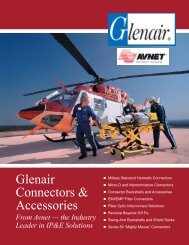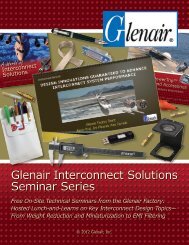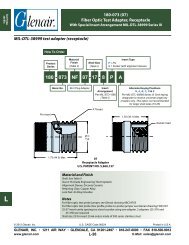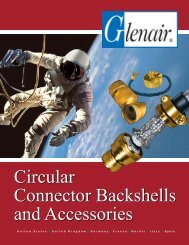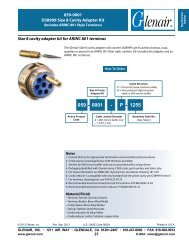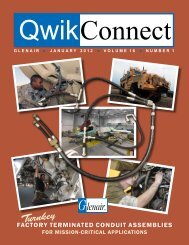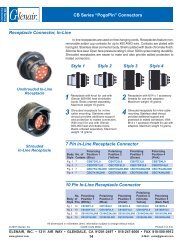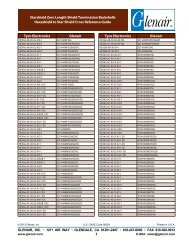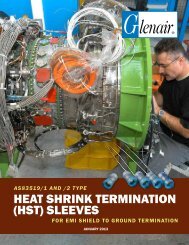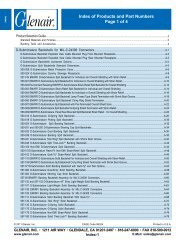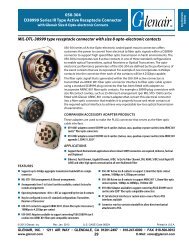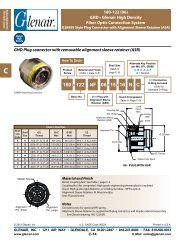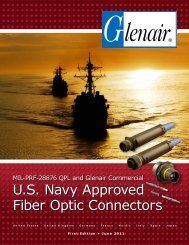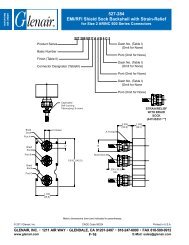Two page spread - Glenair, Inc.
Two page spread - Glenair, Inc.
Two page spread - Glenair, Inc.
You also want an ePaper? Increase the reach of your titles
YUMPU automatically turns print PDFs into web optimized ePapers that Google loves.
Job Six: Resolving Ferromagnetic Material Issues<br />
QwikConnect<br />
In electromagnetism, permeability is the measure of the ability of a material to support the formation of a<br />
magnetic field within itself. In other words, it is the degree of magnetization that a material obtains in response to an<br />
applied magnetic field. Magnetic permeability is typically represented by the Greek letter μ.<br />
Permeability is the measure most commonly employed by interconnect engineers. The more conductive a<br />
material is to a magnetic field, the higher its permeability. While this property may be desirable in certain applications,<br />
it is verboten in interconnect systems serving certain classes of electronic equipment where even low levels of<br />
magnetism can effect circuit performance and degrade signal clarity. Metal materials (see sidebars) that are generally<br />
free of ferromagnetic properties include aluminum, titanium, copper and austenitic stainless steels. Interconnect<br />
designers generally avoid ferromagnetic materials, such as the carbon steels formerly used in many MIL-DTL-24308<br />
D-Subminiature connectors, which can interfere with sensitive instruments. As a benchmark, connectors and other<br />
interconnect components with a maximum permeability of 2 μ are generally required for space. Additionally,<br />
D-Subminiature interconnects must not exceed residual magnetism of 20 gamma for Level C testing—to achieve this<br />
requirement, brass shell materials with gold over copper flash finish are typically used.<br />
Job Seven: Adhering to Known Prohibitions<br />
Several general prohibitions exist for materials which may not be used in space applications, including: Cadmium<br />
plating, due to sublimation regardless of underplate; Zinc plating, due to sublimation regardless of underplate;<br />
Dissimilar metals for all connector parts (refer to MIL-STD-889 for metal compatibility); recycled (regrind) dielectric<br />
materials; Silver underplate or overplate (as it becomes nonconductive from atomic oxygen); localized contact finish<br />
(contacts must have uniform plating over engagement area); Polyvinylchloride; and pure Tin.<br />
Job Eight: Qualifying to Performance Standards<br />
NASA-STD-7001A, Payload Vibroacoustic Test Criteria, sets overall policy for random vibration testing of flight<br />
hardware. The standard calls for random vibration workmanship testing in a hard-mounted test configuration to<br />
screen electrical and mechanical products for flaws and hidden defects. Additionally, the standard establishes<br />
a minimum workmanship random vibration threshold for electrical, electronic, electromechanical, mechanical<br />
components and mechanisms weighing less than 50 kg (110 lbs.). An industry study found more than 80% of all of<br />
their component failures for space vehicles are due to workmanship quality and assembly issues. The Workmanship<br />
vibration test can detect defects not detectable by thermal screens such as loose contact, debris, loose hardware and<br />
mechanical flaws.<br />
Typical Workmanship issues include: Loose<br />
electrical connections; Loose nuts, bolts, etc.;<br />
Physical contaminants (loose foreign matter); Cold<br />
solder joints and solder voids <strong>Inc</strong>omplete weld<br />
joints; Defective piece parts; Improperly crimped<br />
connections; Wire defects; Insufficient clearance;<br />
Shrinkage of or too soft potting material; Wire fatigue<br />
failure due to routing; Loose or missing mounting<br />
hardware.<br />
Here is a summary of the key space-grade<br />
requirements met by <strong>Glenair</strong> that broadly apply to<br />
interconnect components, as defined by NASA as<br />
well as the European Space Agency, the Japanese<br />
Aerospace Exploration Agency and the Russian<br />
Space Agency:<br />
<strong>Glenair</strong> Conformance to Space Agency Interconnect Requirement Standards<br />
NASA ESA JAXA RKA<br />
Non-galvanic, conductive metal materials <br />
Low total mass loss (TML) materials <br />
Qualified outgassing/screening procedures <br />
Sub 2µ magnetic permeability <br />
Cryogenic temperature capable materials <br />
Visual inspection/workmanship standards <br />
Air leakage level testing (hermetic only) <br />
Resistance to soldering heat <br />
Min/max contacts engagement and separation force <br />
Mechanical functionality <br />
Insulation resistance <br />
Voltage (DWV) <br />
Crimp termination standards <br />
Space-Grade Interconnect<br />
Line-Card<br />
The following interconnect technologies are all optimized for use in space application environments, from ground<br />
launch support to deep space. All are available with outgas processing and space-grade materials and plating.<br />
Chose from high-availability catalog products to build-to-order solutions—all with <strong>Glenair</strong>’s “Design-Partner”<br />
promise to deliver exactly what your application demands when and where you need it.<br />
Nanominiature and Micro-D Subminiature Connectors<br />
deliver optimal size and weight reduction and precision<br />
machined shells. TwistPin contacts perform best in high<br />
shock/vibration and high temperature applications.<br />
Series 28 HiPer-D inter-mates and<br />
mounts with standard MIL-DTL-24308<br />
D-subs but delivers out-of-this world<br />
durability and reliability.<br />
Series 970 PowerTrip: The<br />
revolutionary, high-performance<br />
power connector for missioncritical<br />
applications.<br />
Light Weight EMI Cable Shielding: Metal composite<br />
AmberStrand ® and micro-filament Stainless Steel<br />
ArmorLite braided cable shielding provide electrical<br />
and mechanical shielding of interconnect cabling at a<br />
fraction of the weight of nickel copper.<br />
Series 80 Mighty Mouse is the<br />
new space industry standard<br />
for high-performance, ultra<br />
miniature connectors. Save<br />
half the size and weight<br />
compared to D38999.<br />
Locking Sav-Con ® Connector<br />
Savers are available for every<br />
circular and rectangular MS<br />
type connector to eliminate<br />
mating cycle wear and damage<br />
to deliverable connectors.<br />
Series 79 Micro-Crimp is the crimp contact<br />
equipped high-performance rectangular with<br />
outstanding shielding and sealing performance.<br />
MIL-DTL-38999 type special-purpose<br />
circular connectors: from unique<br />
zero-extraction force versions to EMI<br />
filters and hermetics, <strong>Glenair</strong> offers the<br />
widest range of of solutions available<br />
in the space industry.<br />
Special Purpose Connector<br />
Accessories and Composites: From<br />
our Space Station Qwik-Clamp to our<br />
next-generation composites solutions,<br />
<strong>Glenair</strong> Backshells reduce weight and<br />
improve performance.<br />
High-Performance Connector Contacts: from QPL<br />
39029 signal solutions to shielded data contacts,<br />
fiber optic termini and opto-electronic designs,<br />
<strong>Glenair</strong> keeps your space applications connected.<br />
These solutions, and dozens of others, available now from <strong>Glenair</strong>—<br />
The Interconnect Design Partner to the Space Industry<br />
10<br />
QwikConnect • October 2012<br />
QwikConnect • October 2012<br />
11



